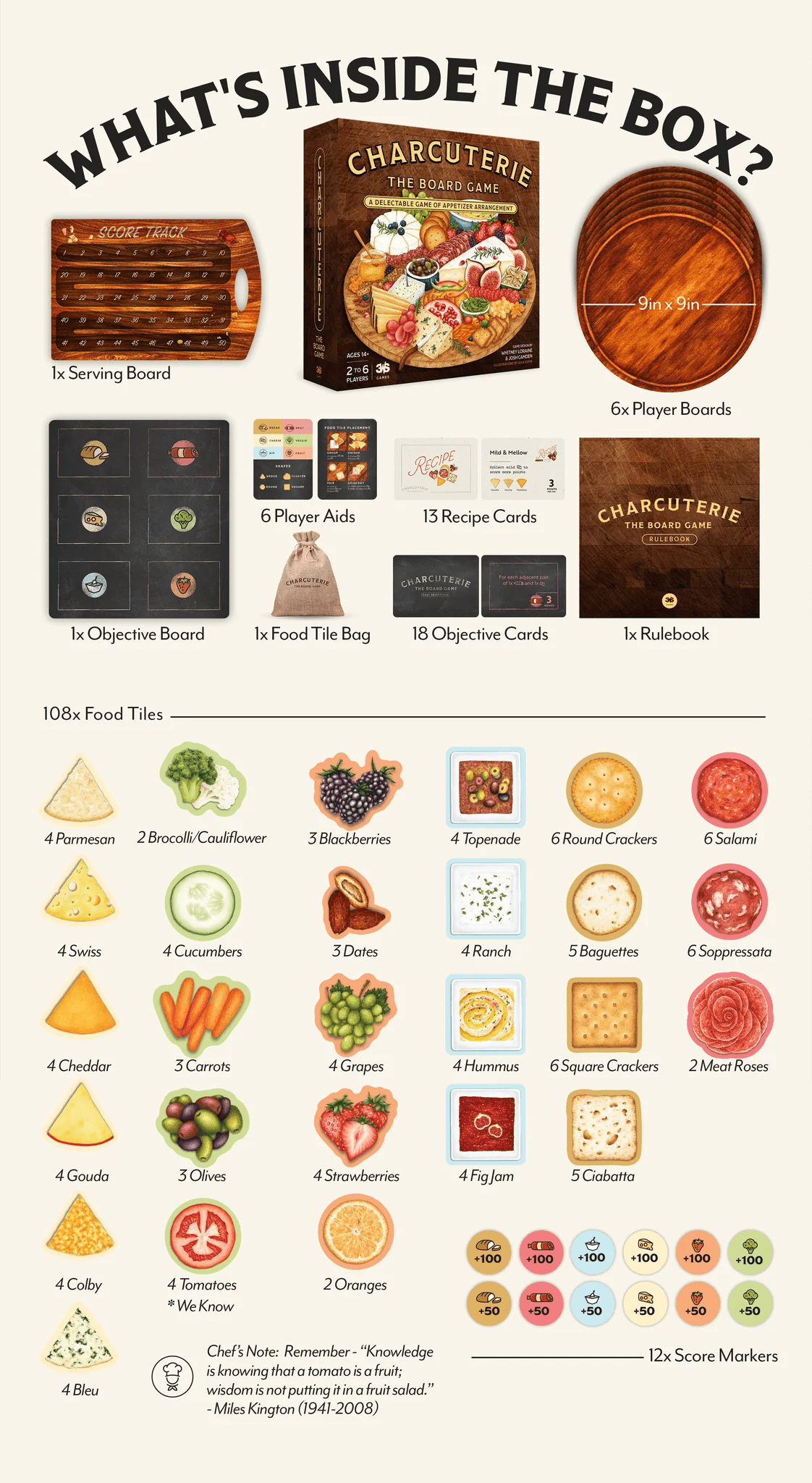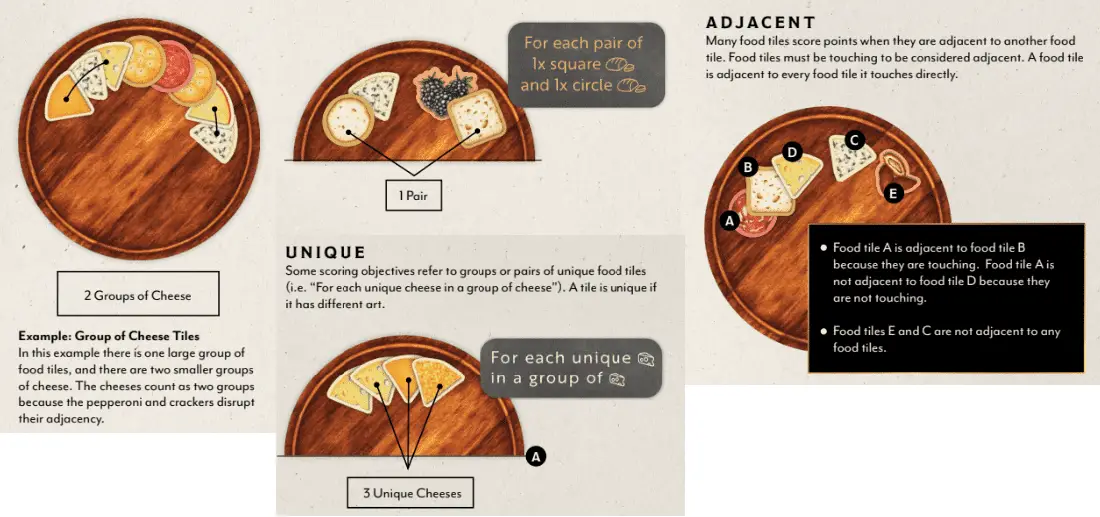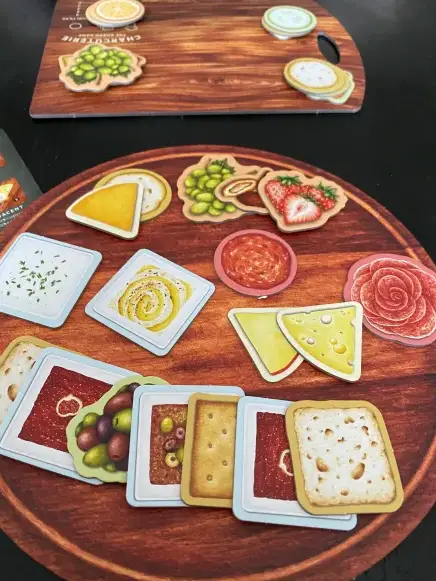Break out your serving boards, cured meats, and accoutrements as you prepare to create a delicious display of eye-catching appetizers in Charcuterie: The Board Game from Th3rd World Studios! As someone who LOVES charcuterie boards (even before they became trendy), I was so intrigued by a board game based on this theme.
In Charcuterie 2-6 players take turns drafting delectable food tiles to their boards, carefully considering their arrangements for final presentation, scoring based on objective and recipe cards that change every game. A quick game, it’s perfect for an introduction to a longer session of gaming, or for a quick one-off before doing whatever else you might want. There’s also ways to extend the game length!
What’s in the box?

Charcuterie comes with a serving board with scoring on the back, a draw back, six player charcuterie boards that look like real boards, 18 objective cards, 13 recipe cards, 1 objective board, 12 double sided scoring markers, and 210 tiles varied across types of bread, cheese, meat, fruit, veggie, and dips.
I loved that the player boards and scoring board look like you would expect while having real charcuterie with friends, and hilariously the board I used to set up actual food to eat while playing looks just like the one in the game! The food tiles are all shaped too for easy identification of tile type, and illustrated well so you can tell the different types apart too.
The objective and recipe cards are linen so feel really nice in the hand, and all the chitboard pieces came out of the full board easily when setting up the game for the first time!
How’s it play?
On the objective board, 1 objective card is randomly chosen and placed for each of the six tile categories. Each player chooses one of two recipe cards that they can score additional points for during final scoring. A random food tile is drawn from the bag, and the person who most recently ate that food becomes the first host.
Charcuterie is a “I Pick, You Choose” game, where players take turns being the host that randomly draws from the bag and decides how to separate them into food tile stacks based on the number of players. So in a two player game, there will be four stacks of three food tiles each. The player to the left of the host chooses a stack to keep, and then the host picks the last stack. In a 2 player game, each player receives 2 stacks.
Each player then organizes the food tiles onto their charcuterie board following four rules and in four kinds of arrangements based on how the players want to score. Tiles must be on the board completely, must be at least half-visible, and cannot hang off the board. In 6 player games, the tiles must all be within the inner ring.
Tiles can be placed in groups (two or more food tiles of specified types on the objective or recipe cards, adjacent or connected in an unbroken series of adjacent tiles), pairs of items (exactly two tiles, but they do not have to touch or be in a group), adjacent (tiles touching), and unique placement (groups or pairs where each tile is unique to that group or pair).

Finally, the current host passes the draw bag and serving board clockwise to the next player. The game ends once every player has taken two complete turns as the host. There’s one final minute of rearranging tiles, and it’s time to score!
Charcuterie also has variants to lengthen the game if you want to spend more time playing depending on the number of players. In a 2 player game, five of each bread type and 2 of each other tile are removed, and the matching cheese gourmet score card is removed. In a 6 player game, players do not start with any tiles and instead, the host draws 18 tiles and creates 6 stacks of 3 tiles each. Each variation helps change up the game a bit!
The verdict?
I think that the first time that you play this game, you must play with charcuterie alongside it, because it was really fun to realize we could use real food to match our game board! Charcuterie could have so easily been gimmicky, but the theme is completely relevant the entire way through. From both the player boards and serving board to the menu and recipe cards, every aspect of this game was thoughtfully designed.

The illustrations on all the food tiles were also lovely, and each food type being a different color made it really easy to move things around in the last frenzied minute of placing tiles for scoring. There are enough unique challenges on the menu cards that you can try to plan ahead when things change on you very quickly, or scoring doesn’t go exactly like you thought, depending on how the other players strategize for their recipe cards (that you can’t see).
I do think that the objective cards need stronger contrast in the print for ease of reading, especially the meat cards. The red on black is difficult to read unless you pick up the card and look at it. Not the end of the world, but one of those quirks in an otherwise really solid game.
If you like games with set collection/tile placement, and food themed options, then Charcuterie is a must have.
You can grab a copy from Th3rd World Studios directly, Amazon, or at your FLGS.
Images and review copy courtesy of Th3rd World Studios
Have strong thoughts about this piece you need to share? Or maybe there’s something else on your mind you’re wanting to talk about with fellow Fandomentals? Head on over to our Community server to join in the conversation!

